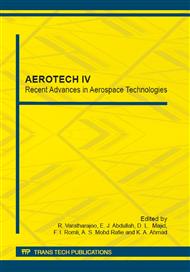p.250
p.255
p.261
p.267
p.275
p.281
p.287
p.293
p.299
A Novel Design of Landing Gear Oleo Strut Damper Using MR Fluid for Aircraft and UAV’s
Abstract:
Most landing gears used in aircraft employ very efficient oleo-pneumatic dampers to absorb and dissipate the impact kinetic energy of the aircraft body frame. A single-acting shock absorber is most commonly used in the oleo strut that has a metering pin extending through the orifice, which can vary the orifice area upon compression and extension of the strut. This variation is adjusted by shaping the metering pin so that the strut load is fairly constant under dynamic loading. In this paper, it is proposed to further change the damping coefficient as a function of time in order to achieve a semi-active control of the aircraft vibrations during landing by using Magnetorheological (MR) fluid in the Oleo. With the metering pin designed for a nominal flight condition, further variation in the fluid viscosity would help achieve the optimal performance in off-nominal flight conditions. A simulation approach is employed to show the effect of different profiles for viscosity variation in the MR fluid. The utility of such a damper can be very well exploited to include different criteria such as the landing distance after touchdown. This type of system can be used also in Unmanned Aerial Vehicle (UAV) application where the focus of design may be to accomplish the task without the consideration of passenger comfort.
Info:
Periodical:
Pages:
275-280
Citation:
Online since:
November 2012
Authors:
Price:
Сopyright:
© 2012 Trans Tech Publications Ltd. All Rights Reserved
Share:
Citation:


